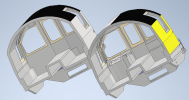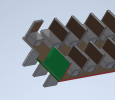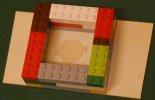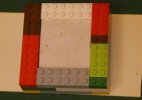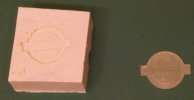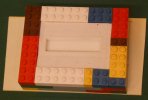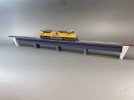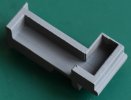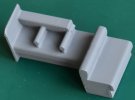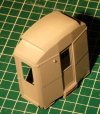Arun Sharma
Western Thunderer
Rather than hi-jack Mickoo's Commercial Models thread I am using this new one to answer Dan Randall's question. Like all threads, it will probably wander a bit.
The original note by Dan was a response to my assertion that 3D printed parts were lifed.
As someone who enjoys designing and 3D printing stuff, but mindful of any potential long-term cons (such as warping and/or brittleness), I’d be interested in knowing more about the polyurethane resin casting process.
For example, do the items being cast need to be sprued in any way (with subsequent clean-up), or are they just cast, as one would wish the final product to appear? Also, what about things like window apertures and the like?
If you have the time and inclination, a thread on the basics of the process, with a few examples of patterns and finished castings would be very interesting please.
(With apologies to Mickoo for the hijack).
Regards
Dan
There are at least six different commonly recognised mechanisms of Additive Manufacture which go under the general heading of 3D printing. The only two generally available to home printers are:
1. Fused Deposition Modelling [FDM] where a thread of hot styrene or polylactic acid is deposited sequentially on a build plate. This process can produce models of great strength and size but they also often have a fairly coarse surface finish with obvious stratification.
2. Stereolithography [SLA] where a part is built up in layers on a metal plate covered in a UV light sensitive acrylic liquid. A UV light source is projected through a series of cross-sections of an object and the light hardens the acrylic liquid where it touches.
Both processes require a CAD file of the object to be printed to be digitally sliced into sections and it is the thickness of these sections that dictates how smooth the final print is. This process is no different to that of an ink jet printer driver chopping up a page and printing it line by line or a colour laser printer driver printing a whole page by printing three or four colour separations at one go.
In a nutshell, the FDM print [Acetyl Butyl Styrene = ABS] has advantages of strength and durability but can lack or distort fine detail. It can be glued to styrene with various solvents and for that reason is popular with folk producing bespoke modification parts for polystyreme models.
Elsewhere on this forum, I've described the creation of a 48 inch long battleship hull and some of its superstructure by means of joining together ABS FDM printed parts:

 The only reason I used FDM ptocesses on the superstructure of the ship was that these parts were either horizonal orvertical with no oblique surfaces. This minimises stratification. However, the gun turrets [15inch and 5.25inch]and the ships' boats clearly had all sorts of strange angles and curves. Thus they had to be printed via the higher resolution SLA process. You can see from the picture that the smaller gun turret print was used as a master for lost wax casting as were the gunbarrels - wonky plastic gun barrels don't look right!
The only reason I used FDM ptocesses on the superstructure of the ship was that these parts were either horizonal orvertical with no oblique surfaces. This minimises stratification. However, the gun turrets [15inch and 5.25inch]and the ships' boats clearly had all sorts of strange angles and curves. Thus they had to be printed via the higher resolution SLA process. You can see from the picture that the smaller gun turret print was used as a master for lost wax casting as were the gunbarrels - wonky plastic gun barrels don't look right!
The hull:

The hull is built up of 22 x FDM [ABS] printed sections glued and bolted together. It could have been printed by SLA but would have been subject to distortion and breakage as its continued exposure to UV light would have continued to make it more and more brittle. Each individual section could have had a cold cure silicone mould made and a polyurethane resin casting made but mould charges x22 would have been prohibitive. Hence ABS used. ABS takes fine surface car body fillers well so the gaps between sections will vanish eventually.
The next section will deal with how to design and print models that are going to be used as masters for some form of casting process.
The original note by Dan was a response to my assertion that 3D printed parts were lifed.
Hi ArunAccepting that many folk choose not to believe that uv cured 3D printed parts are effectively lifed, the alternative [if they are for sale] to ageing them for ten years, is to use them as masters for polyurethane resin casting. Yes, it's more expensive than just printing them but you do have a responsibility to your customers.
As someone who enjoys designing and 3D printing stuff, but mindful of any potential long-term cons (such as warping and/or brittleness), I’d be interested in knowing more about the polyurethane resin casting process.
For example, do the items being cast need to be sprued in any way (with subsequent clean-up), or are they just cast, as one would wish the final product to appear? Also, what about things like window apertures and the like?
If you have the time and inclination, a thread on the basics of the process, with a few examples of patterns and finished castings would be very interesting please.
(With apologies to Mickoo for the hijack).
Regards
Dan
There are at least six different commonly recognised mechanisms of Additive Manufacture which go under the general heading of 3D printing. The only two generally available to home printers are:
1. Fused Deposition Modelling [FDM] where a thread of hot styrene or polylactic acid is deposited sequentially on a build plate. This process can produce models of great strength and size but they also often have a fairly coarse surface finish with obvious stratification.
2. Stereolithography [SLA] where a part is built up in layers on a metal plate covered in a UV light sensitive acrylic liquid. A UV light source is projected through a series of cross-sections of an object and the light hardens the acrylic liquid where it touches.
Both processes require a CAD file of the object to be printed to be digitally sliced into sections and it is the thickness of these sections that dictates how smooth the final print is. This process is no different to that of an ink jet printer driver chopping up a page and printing it line by line or a colour laser printer driver printing a whole page by printing three or four colour separations at one go.
In a nutshell, the FDM print [Acetyl Butyl Styrene = ABS] has advantages of strength and durability but can lack or distort fine detail. It can be glued to styrene with various solvents and for that reason is popular with folk producing bespoke modification parts for polystyreme models.
Elsewhere on this forum, I've described the creation of a 48 inch long battleship hull and some of its superstructure by means of joining together ABS FDM printed parts:

 The only reason I used FDM ptocesses on the superstructure of the ship was that these parts were either horizonal orvertical with no oblique surfaces. This minimises stratification. However, the gun turrets [15inch and 5.25inch]and the ships' boats clearly had all sorts of strange angles and curves. Thus they had to be printed via the higher resolution SLA process. You can see from the picture that the smaller gun turret print was used as a master for lost wax casting as were the gunbarrels - wonky plastic gun barrels don't look right!
The only reason I used FDM ptocesses on the superstructure of the ship was that these parts were either horizonal orvertical with no oblique surfaces. This minimises stratification. However, the gun turrets [15inch and 5.25inch]and the ships' boats clearly had all sorts of strange angles and curves. Thus they had to be printed via the higher resolution SLA process. You can see from the picture that the smaller gun turret print was used as a master for lost wax casting as were the gunbarrels - wonky plastic gun barrels don't look right!The hull:

The hull is built up of 22 x FDM [ABS] printed sections glued and bolted together. It could have been printed by SLA but would have been subject to distortion and breakage as its continued exposure to UV light would have continued to make it more and more brittle. Each individual section could have had a cold cure silicone mould made and a polyurethane resin casting made but mould charges x22 would have been prohibitive. Hence ABS used. ABS takes fine surface car body fillers well so the gaps between sections will vanish eventually.
The next section will deal with how to design and print models that are going to be used as masters for some form of casting process.

